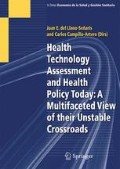Abstract
Like many fathers and grandfathers, I have spent long hours in bad weather on touchlines urging on bunches of muddy little – and not so little – knots of boys and girls in amateur soccer league matches (in my case it has been almost exclusively soccer – a game I never played myself).
Access this chapter
Tax calculation will be finalised at checkout
Purchases are for personal use only
Preview
Unable to display preview. Download preview PDF.
References
http://htaglossary.net/HomePage, accessed 19 May 2014.
Drummond MF, Sculpher MJ, Torrance GW, O’Brien BJ. Methods for the Economic Evaluation of Health Care Programmes. Oxford: Oxford University Press. 1987.
Gold MR, Stevenson D, Fryback DG. HALYs and QALYs and DALYs, oh my: similarities and differences in summary measures of population health. Ann Rev Pub Health. 2002;23:115-34.
Culyer AJ, Lavers RJ, Williams AH. Social indicators: health. Soc Trends. 1971;2:31-42.
Luce BR, Drummond M, Jonsson B, Neumann PJ, Schwartz JS, Siebert U, Sullivan SD. EBM, HTA, and CER: Clearing the Confusion. Milbank Quarterly. 2010; 88:256-76.
Culyer AJ. The Dictionary of Health Economics. Cheltenham: Edward Elgar. 2014.
Wagstaff A, Pradhan M. Health insurance impacts on health and nonmedical consumption in a developing country. ICFAI J Risk and Ins. 2005;2:44-68.
van Doorslaer E, O’Donnell O, Rannan-Eliya RP, Somanathan A, Adhikari SR, Garg CC, et al. Effect of payments for health care on poverty estimates in 11 countries in Asia: an analysis of household survey data. Lancet. 2006;368:1357-64.
Smith DL, Levin SA, Laxminarayan R. Strategic interactions in multi-institutional epidemics of antibiotic resistance. Proc Nat Acad Sci of the USA. 2004;102:3153-8.
Megiddo I, Nandi A, Ashok A, Prabhakaran D, Laxminarayan R. IndiaSim: An Agent-based Model for Extended Cost-Effectiveness Analysis of Secondary Prevention of Coronary Heart Diseases in India, CDDEP working paper, Washington DC: CDDEP. 2014.
National Institute for Clinical Excellence. Supporting the Implementation of NICE Guidance, London: NICE. 2004.
Asaria M, Griffin S, Cookson R, Whyte S, Tappenden P. Distributional Cost-Effectiveness Analysis of Health Care Programmes, CHE Research Paper 91, York: Centre for Health Economics. 2013.
Verguet S, Laxminarayan R, Jamison DT. Universal public finance of tuberculosis treatment in India: an extended cost-effectiveness analysis. Health Econ. 2014. doi: 10.1002/hec.3019. 2014.
Anand P. The integration of claims to health-care: a programming approach. J Health Econ. 2003;22:731-45.
Devlin NJ. Sussex J. (eds.) Incorporating Multiple Criteria in HTA: Methods and Processes. London: Office of Health Economics. 2011.
Morton A. Aversion to health inequalities in healthcare prioritisation: a multicriteria optimisation perspective. J Health Econ. (forthcoming 2014).
Culyer AJ, Lomas J. Deliberative processes and evidence-informed decision-making in health care – do they work and how might we know? Evidence and Policy. 2006;2:357-71.
Murray CJ, Evans DB, Acharya A, Baltussen RM. Development of WHO guidelines on generalized cost-effectiveness analysis. Health Econ. 2000;9:235-51.
Bevan G, Hollingshurst S. Cost per quality adjusted life year and disability adjusted life years: the need for a new paradigm. Expert Rev Pharma and Outcomes Res. 2003;3:469-77.
Robberstad B. QALYs vs DALYs vs LYs gained: what are the differences, and what difference do they make for health care priority setting? Norsk Epid. 2005;15:193-91.
Murray CJ. Quantifying the burden of disease: the technical basis for disability-adjusted life years. Bull World Health Organ. 1994;12:429-45.
Williams A. Calculating the global burden of disease: time for a strategic reappraisal? Health Econ. 1999;8:1-8.
Murray CJL, Lopez AD. Progress and directions in refining the Global Burden of Disease approach: a response to Williams. Health Econ. 2000;9:69-82.
Klarman H, Francis J, Rosenthal G. Cost-effectiveness analysis applied to the treatment of chronic renal disease. Med Care. 1968;6:48-64.
Torrance GW. A Generalized Cost-Effectiveness Model for the Evaluation of Health Programs: A Research Report. Hamilton: McMaster University. 1970.
Zeckhauser R, Shepard DS. Where now for saving lives? Law and Contemp Probs. 1976;40:5-45.
Anand S, Hanson K. Disability-adjusted life years: a critical review. J Health Econ. 1997;16:685-702.
Sassi F. Calculating QALYs, comparing QALY and DALY calculation. Health Pol Plan. 2008;21:402-8.
Hausman D. Valuing health. Phil Pub Affairs. 2006;34:246-74.
Gold MR, Muennig P. Measure-dependent variation in burden of disease estimates: implications for policy. Med Care. 2002;40:260-6.
Johannesson M, Jönsson B, Jönsson L, Kobelt G, Zethreaus N. Why Should Economic Evaluations of Medical Technologies have a Societal Perspective? London: Office of Health Economics. 2009.
Jönsson B. Ten arguments for a societal perspective in the economic evaluation of medical innovations. Eur J Health Econ. 2009;10:357-9.
Turvey R. Present value versus internal rate of return: an essay in the theory of third best. Econ J. 1963;73:93-8.
Author information
Authors and Affiliations
Editor information
Editors and Affiliations
Rights and permissions
Copyright information
© 2015 Springer International Publishing Switzerland
About this chapter
Cite this chapter
Culyer, A.J. (2015). Four Issues in Cost-Effectiveness Analysis and Health Technology Assessment: a View from the Touch-line. In: del Llano-Señarís, J., Campillo-Artero, C. (eds) Health Technology Assessment and Health Policy Today: A Multifaceted View of their Unstable Crossroads. Adis, Cham. https://doi.org/10.1007/978-3-319-15004-8_5
Download citation
DOI: https://doi.org/10.1007/978-3-319-15004-8_5
Published:
Publisher Name: Adis, Cham
Print ISBN: 978-3-319-15003-1
Online ISBN: 978-3-319-15004-8
eBook Packages: Business and EconomicsEconomics and Finance (R0)

